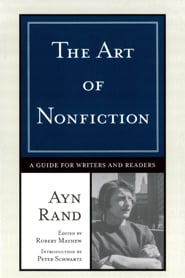

In 1969, Ayn Rand gave a series of informal lectures on the art of nonfiction writing to a select group of friends and associates, often discussing her own writings as way of example and illustration.
As editor and Objectivist scholar Robert Mayhew notes in his preface: “She did not deliver prepared lectures. Instead, she spoke on a topic (some evenings for over three hours) guided solely by a brief outline. These ‘lectures’ were interspersed with: general discussion; requests for clarification, with her replies; discussion of homework assignments; and question-and-answer periods.
The course was privately recorded. My task was to convert the recording into a book.”
In completing his task, Mayhew explains that he cut extraneous material, reorganized what remained and edited it for clarity, the last of which “involved transforming Ayn Rand’s oral presentation into written form, i.e., condensing what she said, eliminating repetitions, and, where necessary, correcting grammar.”
In The Art of Nonfiction, Rand takes readers step by step through the writing process. She discusses the psychological aspects of writing nonfiction and the different roles played by the conscious and subconscious mind. Her focus is not theoretical or journalistic articles but “middle-range” ones — “the application of abstractions to concretes, which is what most intellectual magazines contain.” She explains how to select a subject and theme (“If you have nothing new to say, no matter how brilliantly you can say it, do not do it”); how to identify your audience; and how to write the first draft.
From preparing an outline to polishing an article to mastering an individual writing style, The Art of Nonfiction covers topics of interest to aspiring and accomplished writers alike.
And because Ayn Rand is Ayn Rand, the book is also sprinkled with insights about the nature and application of philosophy, such as a discussion of the difference between Plato’s and Aristotle’s view of abstractions and how this philosophic difference manifests itself, for good or ill, in a writer’s approach.
“The first precondition of this course, and of any type of writing, is: do not get a sense of unearned guilt. If you have difficulty with writing, do not conclude that there is something wrong with you. Writing should never be a test of self-esteem. If things are not going as you want, do not see it as proof of an unknowable flaw in your subconscious.
“Never take the blame for something you do not know. Be sure, however, to take the blame for writing errors you do know about. That much is open to your conscious mind, and pertains to how carefully you edit. . . .
“If you do have any guilt, earned or unearned, that is between you and your psychologist. When you sit down to write, however, you must regard yourself as perfect, omniscient, and omnipotent.”
Writing, according to Ayn Rand, “is literally only the skill of putting down on paper a clear thought, in clear terms. . . . I once said the three most important elements in fiction are plot, plot, and plot. The equivalent in nonfiction is: clarity, clarity, and clarity.” The goal of nonfiction writing is to communicate your ideas, and the clarity of your thinking and your writing will determine whether you have done so successfully or unsuccessfully.
Rand stresses two aspects of achieving clarity: clear thinking and purposeful editing. It is during the process of editing that you must strive to see your article through the eyes of the reader, to assess: Does this actually say what I intend it to say? “The penalty for subjectivism” in thinking, Rand warns, “is the inability to distinguish between what is on paper and what is only in your mind” when you edit.
To write an article, Rand notes, it is important to take seriously the fact that “you cannot do everything at once.” This means that you need to write in certain steps — you must follow a certain process. In The Art of Nonfiction, Rand outlines the essentials of the writing process.
To start with, Rand explains, a writer must choose a subject (what he wants to write about) and a theme (what he wants to say about the subject). Next, he needs to create a “mental plan of action” — an outline that names the essential points by which he intends to demonstrate his theme. Using the outline, he then writes a draft: a first attempt to carry out the instructions of his outline. Finally, he must edit his draft so that it conveys his theme as clearly and persuasively as possible.
In her discussion of this process, Rand identifies many pitfalls and how to avoid them.
Although this book is primarily about nonfiction writing, it also contains a wealth of philosophic material Rand does not cover elsewhere. In one of the most provocative statements in the book, Rand counsels her students, “you need to grasp that there is no such thing as Objectivism or any other philosophy.”
Rand goes on to elaborate, explaining that philosophy is “the study of the fundamental nature of reality,” and, as such, is a body of abstractions. “Every abstraction, and thus every principle, is manifested in an incalculable number of concretes. It is what the concretes have in common — but it does not exist apart from them.”
This means, for instance, that there is not some floating abstraction “man versus the state.” One must never lose sight of the meaning of this idea: the specific individuals in specific eras and countries whose freedom is protected or violated by their government.
Something many writers struggle with is writer’s block, which Rand calls “the squirms.”
Rand not only gives practical advice for dealing with writer’s block, but explains its main cause. “The main reason for it is a subconscious contradiction. . . . Whenever you experience the squirms, some clash of intentions occurs on the subconscious level, as if your inner circuits were tied in knots. You feel paralyzed because your subconscious is struggling with a contradiction, but since it is on the subconscious level, you cannot identify it immediately.”
To solve the squirms, Rand explains: “You must stop writing when they occur, but continue to work on the problem. . . . You must sit at your desk and think about it, even when you feel you do not know what to think. For an exercise in free will and will power, this is the hardest thing you can demand of yourself, but it is the only solution.”
When you write a draft, Rand explains, you function primarily by your subconscious mind: your goal is to get words down on paper, guided by your subject, theme and outline. But then you must edit — a process that calls primarily on your conscious mind. “[Y]ou must be as objective and impersonal as possible. Try to forget what you have written and read it as if it were written by someone else.”
Rand recommends a process she calls “editing in layers” — editing in stages, “by going over your first draft many times, from different aspects,” such as structure, clarity and style.